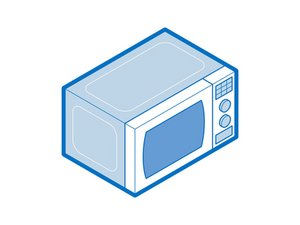Fuse blows when opened during heating
My son asked me to come look at his microwave, saying that it had started out tripping the circuit breaker, but now was completely without power. He could live without the microwave function, but it also houses the exhaust fan and light for the stove, so he'd like those functions working, at least.
This is a Frigidaire Microwave Oven mounted above the stove and providing the vent fan and light for the range, model number FFMV162LMA.
Of course my first thought was door switches, so I bought some and brought them with me, but it doesn't look like that's the problem. Here's the door switch chart from the information sheet packed away inside the microwave.

As verified with a ohmmeter, all functions check out in open and closed positions, and seem to transition correctly when opened and closed.
I found that the 20A AGC fuse was not only blown, but blown to smithereens. I mean, the glass envelope of the fuse had literally exploded; there were pieces of glass spread over the circuit board holding the fuse.
Unfortunately I didn't have any 20A fuses with me; just a few 10A ones, so I had to make do with those until I can pick up the correct replacement. With that in mind, here's what I found.
- All functions seem to operate correctly with a fuse in place.
- Two thermal switches are accessible after opening up the display panel (which also allows access to the door switches as well). Both switches seem to be working; one marked "Bottom Thermal Cut-Out" reads closed and the other, labelled "Hood Thermal Cut-Out" reads open. Checking the data sheet, the hood one closes at high temperature and automatically activates the hood fan. I verified that the circuit works by bypassing the thermal switch and seeing that the fan did indeed come on when the switch is activated.
- Under component tests, the fan motor's normal resistance is supposed to be 97.4 ohms; I got 111 ohms on my measurement. Off by a bit, but I'm assuming that's not enough to be of any concern given the fan is operating correctly.
Here are the two full pages from the Microwave Oven Tech Sheet included inside the microwave.


I explained the situation to my son, that it seemed to be working correctly with the exception that if you opened the door when it is running, it would blow the fuse and that otherwise I thought he could use it until I get it figured out.
However, before I left he went to heat up his lunch and when he did the fuse blew. I don't know if it was because of whatever problem is going on with the microwave or the fact that it was a 10A fuse instead of the 20A that it should have been. For now I'm tempted to discount that as an issue but will verify once I get hold of some 20A fuses and get one installed.
So, after this long-winded diatribe, what do you guys think? Where do I look next to fix the problem?
Update (07/23/23)
Finally got back to my son's house today to continue working on the microwave. I feel like I made some progress, but it's still not working.
I decided to concentrate on the switches first, since the symptoms really seem to be pointing to them not opening/closing in the proper sequence. I pulled the plastic mount that holds the switches and found that one of the switches, the one labelled the monitor switch on the diagram, was coated in gunk and the button was intermittent in operation. Pressing it down, it didn't always spring back up readily and remained in the down position.
Since I already had them, I just went ahead and replaced all three switches with brand new ones. Once I mounted them all, reinstalled the switch holder mechanism and tested them, I'm confident the switches are now fully operational.
After reassembling and testing, I find that everything works fine, including the clock, oven fan and oven lights, right up until I try to turn on the microwave. At that point it either blows the circuit breaker, the fuse, or both.
So I figured it was time to listen to @mayer's advice and check the magnetron. It's a two-person job to dismount it from the wall, so I got my son to help me take it down.
Once I got it on the kitchen table and opened up, I started checking everything I could.
- Magnetron:
The two terminals have continuity between them but none between either one and the case or any other ground. - Transformer:
Primary winding measured .4 Ohm
Secondary winding 117 Ohms
Filament winding: 0 Ohms
According to the troubleshooting sheet, that all checks out as correct. - Capacitor:
Open circuit between either terminal and chassis ground.
Open circuit between terminals. The troubleshooting sheet indicates there should be an initial momentary ohm reading that then goes to an open circuit, but I couldn't get one no matter what range or polarity I tried. Now, it's a very old Radio Shack digital multimeter so it could conceivably be the fault of the meter, but I don't know at this point. - Diode:
Basically got the same results as the capacitor. It measured as an open circuit either way no matter the range or even if I specifically set the meter on diode mode.
So at this point it appears the diode may have failed. Would that account for the fuse blowing? Are my capacitor measurements anything to be concerned about, or should I just go ahead and replace both parts?
Thanks for your help; it is very much appreciated.
crwdns2934109:0crwdne2934109:0


 134
134  67
67  104
104 
